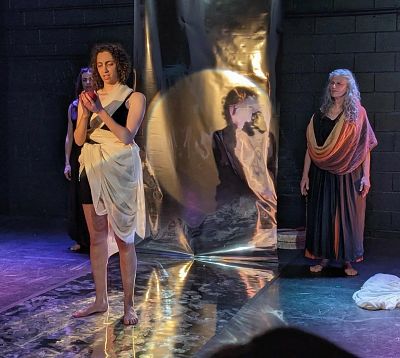
What lies beneath
Click here if you liked this article 15 ![]()
https://www.melbournefringe.com.au/whats-on/events/what-lies-beneath
Date Reviewed: 15/10/2025
“What Lies Beneath” is an ambitious retelling of the Demeter and Persephone myth, reframed through the lens of womanhood. Drawing on themes from first menstruation to menopause, the play honours coming of age, motherhood, grief, and ancestral rhythms through movement, music, and ritual.
At the heart of this staging is Persephone, played by Daphne Gerolymou-Papadopoulos, whose performance anchors the production. We witness her transformation, from an innocent girl, eyes bright with curiosity, learning through mimicking her mother’s gestures, to the visceral moment of her first menstruation, rendered with raw physicality. What follows is a journey of awakening: she hides, she resists, breaks, and finally, she claims her power.
Daphne makes the role her own, as Miller said in a Backstage at Fringe interview, the actress “has been offering herself, her ideas and embodiment to the play. She’s in her 20s and her experiences and curiosities are woven in.” (This talented young actress is definitely one to watch out for).
It is no easy feat to depict first menstruation or stage a scene of rape without the rapist present, yet Daphne manages to do this, channelling both fear and defiance with astonishing emotional honesty. She breathes life into Persephone’s journey, inviting us into moments that are intimate, raw, and painfully human.
At times we feel uncomfortable watching this, voyeuristic even. We're supposed to.
As Miller has noted, “We live in a culture which stigmatises menstruation and menopause. Though there are definitely some positive shifts, the taboo still exists. A consequence of the taboo is shame, shame which is internalised. So, I wanted to write about the power of menstruation, about the whole cycle, and of our rites of passage. I wanted to share some of the wisdom that comes with our descent with menstruation and menopause.”
The script captures this descent with haunting precision: “To flow with the river of blood, home to the dwelling place, a place that has been shamed and disgrace that so many of us believe the lies that we’re inferiors, that our bodies are too messy, too fleshy, too moist, too much, and too blood.”
The pivotal scene, the devouring of the pomegranate, is both transgressive and liberating. The fruit splashes open, glistening, as Persephone consumes it with relish, her surrender to the forbidden act both shocking and sacred, a reclaiming of her own body and future.
There are flashes of beauty and insight throughout, fragments of poetry (Greek, Italian and English), striking imagery, bold choices, yet the piece as a whole would benefit from tighter editing and stronger connective tissue between its many compelling ideas. Hecate’s presence, for instance, while magnetically performed by Clare Larman, feels somewhat untethered from the central narrative. Meanwhile, the mother-daughter dynamic between Demeter, played by Rosa Voto, and Persephone occasionally loses emotional cohesion.
The axis of the myth is presented in parallel rather than tightly intertwined. Demeter's grief and Persephone's awakening are presented as simultaneous separate journeys. We see a mother's intellectual despair rather than maternal anguish, and we are not entirely convinced of her pain. This leaves the audience to observe two separate narratives rather than a shared tragedy.
The detachment may be deliberate, but it risks emotional flatness. Miller’s framing, that Demeter’s grief extends beyond her daughter to encompass shifting relationships and even planetary despair, is intellectually potent, yet on stage, it sometimes distances rather than deepens our empathy.
Visually, the production is interesting. The set by Louisa Fitzgerald consists of enveloping curtains that become Persephone's veils. Shimmering mirrored sheets with occasional fog create an atmosphere that is intimate and otherworldly.
Lighting designer Amelia Lumley has taken advantage of the curtains, smokes and mirrors, infusing drama with shifts from golden fertility to underworld black, mirroring the myth’s emotional terrain.
Acoustically, the production oscillates between the ancient and the experimental. At times, the ensemble’s multilingual chanting evokes the chorus of classical Greek tragedy; at others, the soundscape becomes almost primal: frogs croak in the underworld, instruments wail like distant spirits. Yet, on occasion, the layering of sound overwhelms the text, drowning out the poetry of the words.
Ultimately, “What Lies Beneath” is a heartfelt feminist work with a courageous spirit, or as Miller describes it, “a lament and a celebration”. It is also a reminder of myth’s enduring power to shed light on our contemporary experience. Like the cycles it celebrates, this production feels as though it is in transit, a continuous process that is in a state of becoming.
It’s close, just a few tweaks away from blooming fully. But even just as it is, there's plenty of food for thought.
Highlights
- A bold feminist reimagining of an ancient myth, with a rich exploration of womanhood
- Evocative physical performance by Daphne Gerolymou-Papadopoulos
- The multilingual component adds even greater universality to the myth
- Striking visual design using curtains, mirrors, and light as ritual elements
- The pomegranate that falls out of nowhere (Was it thrown? Did it fall from the ceiling?)
- A catalyst for rich post-performance discussion (there's a lot to unpack).
Who it’s for
Audiences drawn to feminist theatre, mythic storytelling, and ritual performance. It’s particularly suited to viewers interested in women’s embodiment, transformation, and intergenerational experience, as well as lovers of experimental and physical theatre seeking work that is both intellectually and viscerally engaging. For those who like ambiguity, and to add their own meaning and interpretations to works.
“What Lies Beneath” is performed at the Explosives Factory at 6:30pm nightly until 18 October and is part of the Melbourne Fringe Festival.
Reviewed by Mary Sinanidis